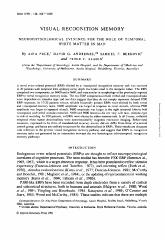Please use this identifier to cite or link to this item:
https://ahro.austin.org.au/austinjspui/handle/1/10689Full metadata record
| DC Field | Value | Language |
|---|---|---|
| dc.contributor.author | Puce, Aina | en |
| dc.contributor.author | Andrewes, D G | en |
| dc.contributor.author | Berkovic, Samuel F | en |
| dc.contributor.author | Bladin, Peter F | en |
| dc.date.accessioned | 2015-05-16T00:13:20Z | |
| dc.date.available | 2015-05-16T00:13:20Z | |
| dc.date.issued | 1991-08-01 | en |
| dc.identifier.citation | Brain : A Journal of Neurology; 114 ( Pt 4)(): 1647-66 | en |
| dc.identifier.govdoc | 1884171 | en |
| dc.identifier.other | PUBMED | en |
| dc.identifier.uri | https://ahro.austin.org.au/austinjspui/handle/1/10689 | en |
| dc.description.abstract | A novel event-related potential (ERP) elicited by a visuospatial recognition memory task was recorded in 20 patients with temporal lobe epilepsy using depth electrodes sited in the temporal lobes. The ERPs comprised two components, an N400 and a P600, and were similar in morphology to the previously reported ERP to verbal recognition memory tasks. The two ERP components in both verbal and visuospatial tasks were dependent on stimulus type and our data suggest that they do not simply represent delayed P300 ERP responses. In 17/20 patients robust, reliable bilaterally present ERPs were elicited by both verbal and visuospatial memory tasks. N400 amplitude was larger in response to novel stimuli, whereas P600 amplitude was larger to repeated stimuli. P600 amplitude was larger in the right temporal lobe to both visuospatial and verbal stimulus material. N400 and P600 latencies did not vary with task, stimulus type or side of recording. In 3/20 patients, no ERPs were elicited by either memory task. In all 3 cases, unilateral temporal white matter abnormalities were demonstrated by magnetic resonance imaging. Behavioural measures, expressed in the form of standardized accuracy scores, did not differ from those of a normal control group, and hence are unlikely to account for the abnormalities in ERPs. These results are discussed with reference to the primate visual recognition memory pathway and suggest that ERPs to recognition memory tasks are generated by an interaction between the two homologous inferotemporal recognition memory pathways. | en |
| dc.language.iso | en | en |
| dc.subject.other | Adult | en |
| dc.subject.other | Analysis of Variance | en |
| dc.subject.other | Behavior | en |
| dc.subject.other | Electrophysiology | en |
| dc.subject.other | Epilepsy, Temporal Lobe.diagnosis.physiopathology | en |
| dc.subject.other | Evoked Potentials, Visual.physiology | en |
| dc.subject.other | Female | en |
| dc.subject.other | Humans | en |
| dc.subject.other | Magnetic Resonance Imaging | en |
| dc.subject.other | Male | en |
| dc.subject.other | Models, Neurological | en |
| dc.subject.other | Neuropsychological Tests | en |
| dc.subject.other | Pattern Recognition, Visual.physiology | en |
| dc.subject.other | Space Perception.physiology | en |
| dc.subject.other | Temporal Lobe.pathology.physiology | en |
| dc.subject.other | Visual Perception.physiology | en |
| dc.title | Visual recognition memory. Neurophysiological evidence for the role of temporal white matter in man. | en |
| dc.type | Journal Article | en |
| dc.identifier.journaltitle | Brain | en |
| dc.identifier.affiliation | Department of Neurology, Austin Hospital, Heidelberg, Victoria, Australia | en |
| dc.description.pages | 1647-66 | en |
| dc.relation.url | https://pubmed.ncbi.nlm.nih.gov/1884171 | en |
| dc.type.austin | Journal Article | en |
| local.name.researcher | Berkovic, Samuel F | |
| item.cerifentitytype | Publications | - |
| item.grantfulltext | open | - |
| item.languageiso639-1 | en | - |
| item.fulltext | With Fulltext | - |
| item.openairetype | Journal Article | - |
| item.openairecristype | http://purl.org/coar/resource_type/c_18cf | - |
| crisitem.author.dept | Epilepsy Research Centre | - |
| crisitem.author.dept | Neurology | - |
| crisitem.author.dept | Neurology | - |
| Appears in Collections: | Journal articles | |
Files in This Item:
| File | Description | Size | Format | |
|---|---|---|---|---|
| 1884171.pdf | 2.76 MB | Adobe PDF |  View/Open |
Page view(s)
64
checked on Mar 10, 2025
Download(s)
198
checked on Mar 10, 2025
Google ScholarTM
Check
Items in AHRO are protected by copyright, with all rights reserved, unless otherwise indicated.
